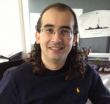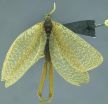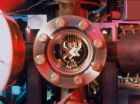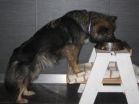(Press-News.org) WATERLOO, Ont. (Thursday, Feb. 14, 2013) A team of researchers at the University of Waterloo's Institute for Quantum Computing has proposed a new computational model that may become the architecture for a scalable quantum computer.
In a paper to be published in the journal Science this week, the research team of IQC Associate Professor Andrew Childs, post-doctoral fellow David Gosset and PhD student Zak Webb proposes using multi-particle quantum walks for universal computation. In a multi-particle quantum walk, particles live on the vertices of a graph and can move between vertices joined by an edge. Furthermore, nearby particles can interact with each other.
Traditionally, a quantum algorithm is implemented on a register of qubits by actively manipulating the qubits according to a set of desired operations. In this new model, a desired quantum algorithm can be implemented by letting the qubits "quantum walk" on an appropriately chosen graph, without having to control the qubits. The process is analogous to a billiard-ball computer where classical logic gates are performed using collisions.
Many previous quantum-walk experiments have not been scalable. But this new model proposed by Childs and his team identifies the requirements to implement quantum walks so they have the potential for significant quantum speedup, paving the way for scalable future experiments. The model could be naturally realized in a variety of systems, including photons with interactions mediated by superconducting circuits.
Quantum walk-based computing is particularly promising because of its universality. "In principle we can cast any quantum algorithm into this model," says Childs. In future work, Childs and his team are interested in applying the model to develop new quantum algorithms and to study problems in quantum computational complexity.
###
About the Institute for Quantum Computing (IQC)
The Institute for Quantum Computing (IQC) is a multidisciplinary scientific research institute at the University of Waterloo. Our research focuses on harnessing the quantum laws of nature to discover and develop powerful new technologies that will transform information technology and drive the 21st century economy. IQC research bridges theory and experiments in quantum computing, quantum communication and other quantum devices through the collaboration of over 200 computer scientists, engineers, mathematicians, physical scientists and students. Established in 2002, IQC also offers graduate and post-graduate programs and educational outreach activities that inspire scientific discovery in the realm of quantum mechanics.
About the University of Waterloo
In just half a century, the University of Waterloo, located at the heart of Canada's technology hub, has become one of Canada's leading comprehensive universities with 35,000 full- and part-time students in undergraduate and graduate programs. Waterloo, as home to the world's largest post-secondary co-operative education program, embraces its connections to the world and encourages enterprising partnerships in learning, research and discovery. In the next decade, the university is committed to building a better future for Canada and the world by championing innovation and collaboration to create solutions relevant to the needs of today and tomorrow. For more information about Waterloo, visit www.uwaterloo.ca.
Media contact
Tobi Day-Hamilton
Associate Director, Communications and External Relations
Institute for Quantum Computing
University of Waterloo
http://www.iqc.uwaterloo.ca
Scientific contact
Andrew Childs
Institute for Quantum Computing
University of Waterloo
amchilds@uwaterloo.ca END
University of Waterloo researchers propose breakthrough architecture for quantum computers
2013-02-15
ELSE PRESS RELEASES FROM THIS DATE:
UTSW researchers identify new enzyme that acts as innate immunity sensor
2013-02-15
DALLAS – Feb. 15, 2013 – Two studies by researchers at UT Southwestern Medical Center could lead to new treatments for lupus and other autoimmune diseases and strengthen current therapies for viral, bacterial, and parasitic infections.
The studies identify a new enzyme that acts as a sensor of innate immunity – the body's first line of defense against invaders – and describe a novel cell signaling pathway. This pathway detects foreign DNA or even host DNA when it appears in a part of the cell where DNA should not be. In addition, the investigations show that the process ...
Researchers uncover new findings on genetic risks of Behçet's disease
2013-02-15
ANN ARBOR, Mich. — Researchers don't know the exact cause of Behçet's disease, a chronic condition that leads to oral and genital sores and serious complications such as blindness, but new research brings better understanding to what makes some people more susceptible to being affected.
In one of the most extensive genetic analyses of Behçet's disease, a University of Michigan-led, international team of researchers has identified novel gene variants in the inflammatory disorder and uncovered data that could apply to studies of other diseases. The results appear in the ...
Spectacular forcepfly species discovered for the first time in South America
2013-02-15
Forcepflies are usually known as earwigflies, because the males have a large genital forceps that resembles the cerci of earwigs. A new species of forcepfly Meropeidae (Mecoptera) from Brazil was described, representing only the 3rd extant species described in this family and the 1st record of the family from the Neotropical region. The distribution and biogeography of the family are discussed and it is even proposed that Meropeidae originated before continental drift and then divided into two branches, northern and southern, with the breakup of the old supercontinent Pangea. ...
This is why it takes so long to get over tendon injuries
2013-02-15
The Achilles heel of the body – getting over damage to tendons can be a long and painful process. By combining the nuclear tests of the 1950s with tissue samples and modern technology, a research collaboration between the Aarhus University and University of Copenhagen now reveals why the healing process is so slow.
Many people are affected by injuries caused by straining the Achilles tendon and other tendons in the body. Danish athletes alone account for up to 200,000 injuries per year. This often leads to frustration over the poor treatment options available, and it can ...
Research uncovers a potential link between Parkinson's and visual problems
2013-02-15
The most common genetic cause of Parkinson's is not only responsible for the condition's distinctive movement problems but may also affect vision, according to new research by scientists at the University of York.
Parkinson's, the second most common form of neurodegenerative disease, principally affects people aged over 60. Its most common symptom is tremor and slowness of movement (bradykinesia) but some people with Parkinson's also experience changes in vision.
Now for the first time, researchers in the University's Department of Biology have established a link between ...
Playing quantum tricks with measurements
2013-02-15
This press release is available in German.
A team of physicists at the University of Innsbruck, Austria, performed an experiment that seems to contradict the foundations of quantum theory -- at first glance. The team led by Rainer Blatt reversed a quantum measurement in a prototype quantum information processor. The experiment is enabled by a technique that has been developed for quantum error correction in a future quantum computer.
Measurements on quantum systems have puzzled generations of physicists due to their counterintuitive properties. One of them is the fact ...
Can hospital readmission rates be trusted?
2013-02-15
MAYWOOD, Il. - When hospital patients have to be readmitted soon after discharge, hospitals look bad.
A high readmission rate also can result in reduced Medicare reimbursements. But a study of spine surgery patients has found that the standard method used to calculate readmission rates is a misleading indicator of hospital quality. Loyola University Medical Center neurosurgeon Beejal Amin, MD, and colleagues found that 25 percent of the readmissions of spine surgery patients were not due to true quality-of-care issues.
Results are reported in a featured article in the ...
The same genetic defect causes Pompe disease in both humans and dogs
2013-02-15
Pompe disease, a severe glycogen storage disease appearing in Lapphunds is caused by a genetic defect in acid α-glucosidase gene. The same genetic mutation also causes the equivalent disease in humans. Based on this finding, canine Pompe disease can now be diagnosed with a genetic test.
This research was completed at the Canine Genetics Research Group lead by professor Hannes Lohi in the University of Helsinki and Folkhälsan Research Center in Finland and will be published in PLOS ONE on February 14, 2013.
Human Pompe disease is caused by complete or partial deficiency ...
The discovery of a new genus of crustacean and 5 new species
2013-02-15
Experts from the Centre for Advanced Studies of Blanes and the University of Barcelona (UB) collected and studied different crustacean specimens during recent expeditions to Madagascar, New Caledonia, Vanuatu, the Philippines and French Polynesia.
Using morphological and molecular data they have discovered five new species of crustaceans in the waters of these regions. They are genetically different but morphologically very similar and they also found a new genus, named Triodonthea. The five new species documented in the study belong to the Lauriea genus of the Galatheidae ...
Force is the key to granular state-shifting
2013-02-15
Ever wonder why sand can both run through an hourglass like a liquid and be solid enough to support buildings? It's because granular materials – like sand or dirt – can change their behavior, or state. Researchers from North Carolina State University have found that the forces individual grains exert on one another are what most affect that transition.
Physicists have explored the changing behavior of granular materials by comparing it to what happens in thermodynamic systems. In a thermodynamic system, you can change the state of a material – like water – from a liquid ...






